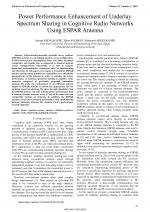| 1/2016 - 9 |
Power Performance Enhancement of Underlay Spectrum Sharing in Cognitive Radio Networks Using ESPAR AntennaABDALRAZIK, A. |
| Extra paper information in |
| Click to see author's profile in |
| Download PDF |
Author keywords
antenna arrays, antenna radiation patterns, cognitive radio, MATLAB, multipath channels
References keywords
antennas(10), communications(9), antenna(8), radio(7), beamforming(7), cognitive(6), single(5), propagation(5), papadias(5), networks(5)
Blue keywords are present in both the references section and the paper title.
About this article
Date of Publication: 2016-02-28
Volume 16, Issue 1, Year 2016, On page(s): 61 - 68
ISSN: 1582-7445, e-ISSN: 1844-7600
Digital Object Identifier: 10.4316/AECE.2016.01009
Web of Science Accession Number: 000376995400009
SCOPUS ID: 84960098493
Abstract
Electronically-steerable parasitic array radiator (ESPAR) antenna is a promising antenna array configuration. It offers lower power consumption, lower cost, lower hardware complexity, and smaller size as compared to classical antenna arrays configurations. Meanwhile it is able to support important communication techniques such as beamforming and diversity. In this paper, we propose a transmitter ESPAR antenna system where symbols are transmitted over switchable beampatterns of the antenna in order to enhance the power performance of underlay spectrum sharing in cognitive radio networks compared to previously proposed transmitter systems. We study the performance of two different pattern shapes of ESPAR antenna to choose the appropriate one for underlay spectrum sharing. We show through simulation that the ESPAR antenna can offer a better power performance than a classical circular antenna array (CAA) of the same size and comparable number of elements. In addition, the ESPAR antenna can preserve its good performance with small spacing between elements, whereas the classical CAA's performance severely degrades. |
| References | | | Cited By |
Web of Science® Times Cited: 0
View record in Web of Science® [View]
View Related Records® [View]
Updated 2 days, 2 hours ago
SCOPUS® Times Cited: 0
View record in SCOPUS® [Free preview]
[1] Fuzzy Hypothesis Test for Cognitive Radios, ILGIN, Fatih Yavuz, Erzincan Üniversitesi Fen Bilimleri Enstitüsü Dergisi, ISSN 2149-4584, Issue 1, Volume 14, 2021.
Digital Object Identifier: 10.18185/erzifbed.734998 [CrossRef]
Disclaimer: All information displayed above was retrieved by using remote connections to respective databases. For the best user experience, we update all data by using background processes, and use caches in order to reduce the load on the servers we retrieve the information from. As we have no control on the availability of the database servers and sometimes the Internet connectivity may be affected, we do not guarantee the information is correct or complete. For the most accurate data, please always consult the database sites directly. Some external links require authentication or an institutional subscription.
Web of Science® is a registered trademark of Clarivate Analytics, Scopus® is a registered trademark of Elsevier B.V., other product names, company names, brand names, trademarks and logos are the property of their respective owners.
Faculty of Electrical Engineering and Computer Science
Stefan cel Mare University of Suceava, Romania
All rights reserved: Advances in Electrical and Computer Engineering is a registered trademark of the Stefan cel Mare University of Suceava. No part of this publication may be reproduced, stored in a retrieval system, photocopied, recorded or archived, without the written permission from the Editor. When authors submit their papers for publication, they agree that the copyright for their article be transferred to the Faculty of Electrical Engineering and Computer Science, Stefan cel Mare University of Suceava, Romania, if and only if the articles are accepted for publication. The copyright covers the exclusive rights to reproduce and distribute the article, including reprints and translations.
Permission for other use: The copyright owner's consent does not extend to copying for general distribution, for promotion, for creating new works, or for resale. Specific written permission must be obtained from the Editor for such copying. Direct linking to files hosted on this website is strictly prohibited.
Disclaimer: Whilst every effort is made by the publishers and editorial board to see that no inaccurate or misleading data, opinions or statements appear in this journal, they wish to make it clear that all information and opinions formulated in the articles, as well as linguistic accuracy, are the sole responsibility of the author.





